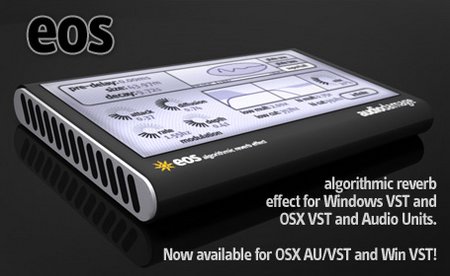
Audio Damage has introduced Eos, a relatively inexpensive ($49) high-quality algorithmic reverb plug-in for Mac & Windows.
You can preview Eos below:
[display_podcast]This is an upright grand piano recorded to tape with a single Neumann microphone. A couple dry chords go by, then Eos at about 15% wet. The algorithm is Superhall, with a long decay, a medium size, and a bit of modulation.
More demos at the Audio Damage site.
Description:
Eos consists of three high-quality custom-designed reverb algorithms, made with the modern production environment in mind. Two different plate simulators and our own Superhall algorithm give you a broad palette of reverb, and the easy-to-understand interface makes adjusting the algorithms to suit your track incredibly simple.
Want a traditional dark plate reverb? Eos can do that. How about a short, dense room sound for your drum buss? Not a problem. But where Eos really comes in to its own is when you drop Superhall on your piano or synthesizer tracks. The incredibly long modulated hall sounds of Eno-style ambience are where Eos thrives, something that is made of unobtanium with convolution ‘verbs. Quite simply, an impulse response can not do what Eos does.
Features:
- Three custom-designed algorithms: Plate 1 (mono in, stereo out), Plate 2 (true stereo), and Superhall (true stereo) built with modern production in mind.
- All standard reverb controls, including modulation rate and depth, attack, diffusion, and full control over the EQ and multipliers of the reverb tail.
- Infinite control for “freeze” effects.
- Unique visual controls designed for quick and easy programming.
- Low CPU usage compared to other algorithmic reverb plug-ins, and far lower than the average convolution ‘verb.
- Full MIDI learn for hardware control of most parameters (VST only).

I have no experience with the product, but the ad graphic is confusing — it can lend an extra sense of depth (and in some cases, mislead) to extrude a 2D soft synth or effect into what appears to be hardware. Here, the pseudo-knobs aren't even popped out, and the whole thing is at an awkward angle, making it easy to tell what the controls say.
The sample is deliciously ambient and moody, and reminds me, there's more Audio Damage stuff I wanna check out.
Yes – 3D graphics for software products must DIE!
This is up there with the butt cheeks Deckadance ad, in my book.
What about using fake 3d in the actual plugin? http://akmedia.digidesign.com/products/images/enl…
Whoa – that's really annoying!
I do like how Eos sounds, though.